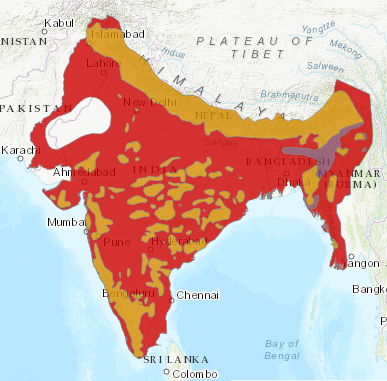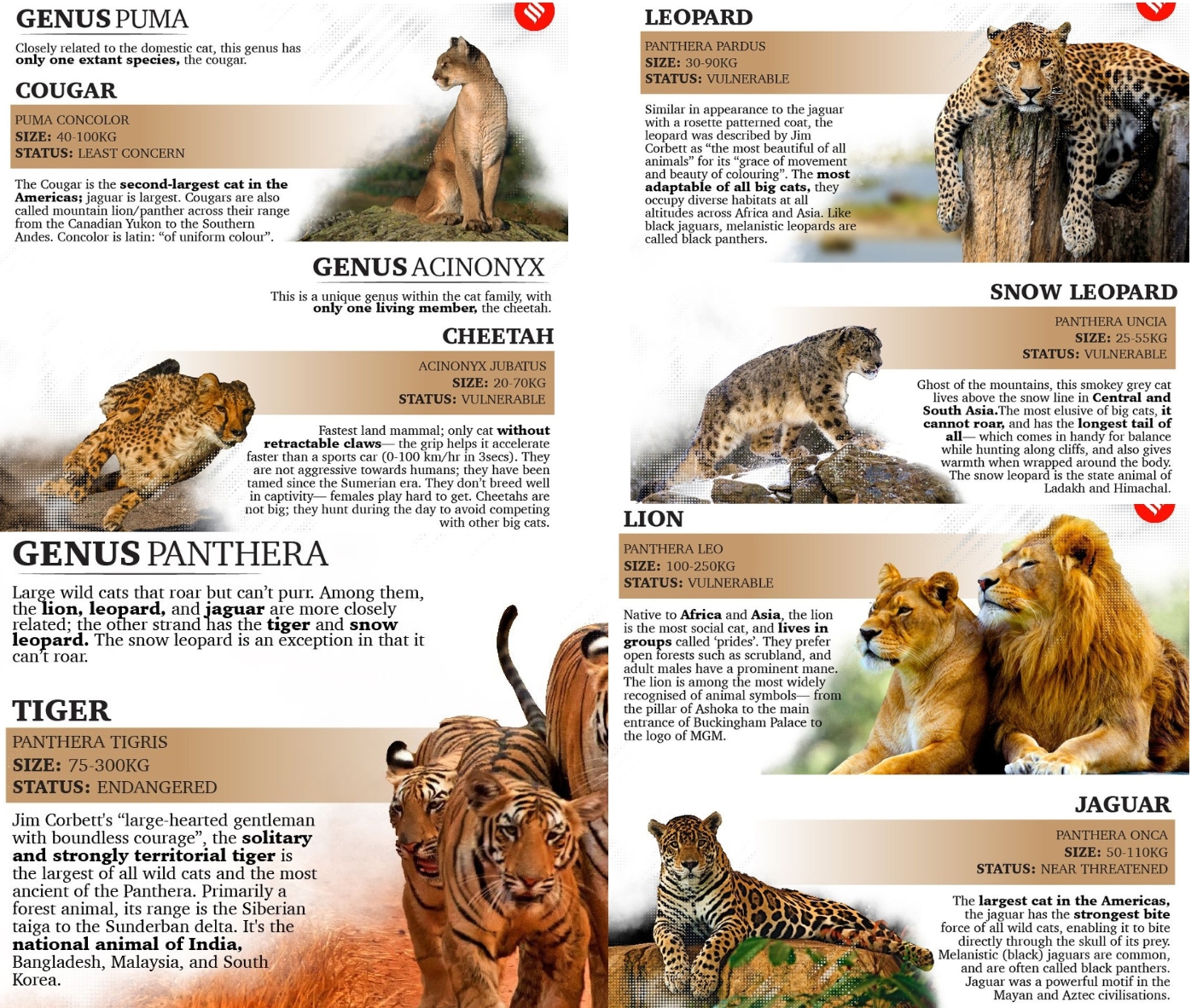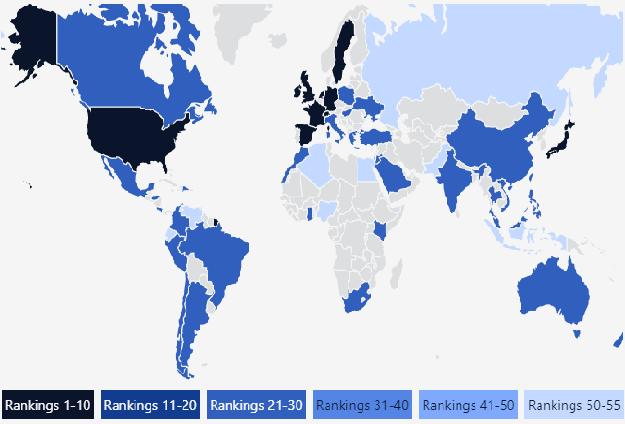Status of Leopards in India Report
Recently, the 5th cycle of leopard population estimation (2022) was carried out and ‘the Status of Leopards in India’ report was released.
- Aim – To reveal crucial insights into leopard distribution and conservation challenges.
- Conducted by – National Tiger Conservation Authority (NTCA), Wildlife Institute of India (WII) in collaboration with State Forest Departments.
- It is under quadrennial “Monitoring of Tiger, Co-predators, prey and their habitat” exercise in tiger range States.
- Coverage – 20 States of India, and focussed on about 70% of the animals’ expected habitat, which are India’s tiger reserves and protected forest areas.
- Forested habitats within 18 tiger states, covering 4 major tiger conservation landscapes.
- Non-forested habitats, arid, and high Himalayas, total of about 30% area were not sampled for leopard.
- Scientific methodologies – A meticulous process combining camera trapping, habitat analysis, and population modelling.
Key Findings of the report
- 8% rise in numbers from 2018 to 2022 with 13,874 individuals (Range - 12,616 to 15,132).
- A 1.08% per annum growth in sample area from 2018.
- The largest growth rate of 1.5%, in Central India & Eastern Ghats.
- A 3.4% decline per annum in Shivalik hills and Gangetic plains.
- Only 4 States reported over a 1,000 animals, where Madhya Pradesh houses the largest followed by Maharashtra, Karnataka and Tamil Nadu.
- Tiger Reserves or sites with highest leopard population
- Nagarajunasagar Srisailam (Andhra Pradesh), followed by Panna (Madhya Pradesh), and Satpura (Madhya Pradesh).
- Threats – Habitat loss, human-wildlife conflict, and poaching.
- Human-wildlife conflict likely reason for decline in the big cat population by 22% in Uttarakhand.
Unlike tigers, which are largely confined to forest reserves, leopards are far more adaptable and tend to be found in villages and, sometimes, even in cities where they prey on cattle and feral dogs. Thus, involved in conflict, resulting in higher mortality.
- Significance – The findings underscore the critical role of Protected Areas in conserving leopard populations.
|
Indian Leopard
|
- Scientific Name – Panthera pardus fusca
- Conservation Status
- IUCN - Near Threatened
- CITES - Appendix I
- WPA, 1972 - Schedule I

|
References
- PIB| Status of Leopards in India Report
- The Hindu| Findings from 5th Assessment of Leopards in India
International Big Cat Alliance (IBCA)
The Union Cabinet approved the establishment of International Big Cat Alliance (IBCA) with a one-time budgetary support of Rs.150 crore for a period of 5 years from 2023-24 to 2027-28.
- It is a multi-country, multi-agency coalition.
- Launched in – 2023, by India in commemoration of 50th anniversary of Project Tiger (1973).
- Objective – To ensure cooperation for the conservation of 7 big cats by arresting decline in population and reverse the trend.
- To establish a central repository for knowledge sharing, capacity building, networking, advocacy, finance and support research.
- Partnership – 96 big cat range countries, also include interested non-range countries, conservation partners and scientific organisations working in the field of big cat conservation.
- Administration – An assembly of members, a standing committee as well as a secretariat based in India.
- Framework of Agreement (statute) – It has been drafted largely on the pattern of the International Solar Alliance (2015).
Big Cats
- Big Cat – A term that is used in informal speech to apply to any large species of the family Felidae.
- Usually, it applies to the members of the genus Panthera but 2 other cats Puma (Puma concolor) and Cheetah (Acinonyx jubatus) are also usually included in most listings of ‘big cats’.
- 7 Big cats – Lion, tiger, leopard, cheetah, snow leopard, jaguar, and puma.
The Indian subcontinent has been historically home to the Bengal tiger, Asiatic lion, Indian leopard, Indian/Asiatic cheetah as well as Snow leopard.
- In India – 5 out of 7 cats except jaguar and puma are found here.
- While cheetah was declared extinct in 1952, it is now reintroduced as a part of Cheetah reintroduction project.

References
- The Indian Express| International Big Cat Alliance (IBCA)
- Down To Earth| Big Cats
Solar Radiation Modification (SRM)
In a recent meeting, UN delegates withdrew a motion calling for more research into technologies of solar radiation modifications.
- SRM – It aims to address a symptom of climate change by reducing the Earth’s temperature.
- By reflecting more sunlight back into space (or)
- By allowing more infrared radiation from Earth to escape
- Need – There is increasing risk of overshooting 1.5 degree Celsius global warming.
- Methodologies – It includes numerous proposed methods which differ significantly.
- Ground reflection – Painting structures with reflective paints and planting crops with high reflectivity
- Marine Cloud Brightening (MCB) – Spraying sea salt into low-lying clouds to increase their brightness.
- Stratospheric Aerosols Injection (SAI) – Spraying large quantities of tiny particles like Sulphur dioxides or finely powdered calcium carbonate into the earth’s stratosphere.
- Space reflection – Placing reflectors or shields in space
- Exiting IR radiation – Removing IR-absorbing clouds from the atmosphere

- Challenges – None of the methodologies are ready for deployment.
- There could be about possible impacts on weather patterns and agriculture, especially in poorer countries.
- It could serve as an excuse to delay cutbacks on greenhouse gas emissions.
Solar Radiation Modification (SRM) is also known as Solar Radiation Management, Radiation Modification Measures or Solar Geoengineering.
References
- The Hindu| UN action on Solar Radiation Modification research
- IIS| Solar Radiation Modifications (SRM)
International IP index
India ranks 42 out of 55 in the 12th edition of International Intellectual Property Index.
- Aim – To show economies how to improve IP-driven innovation and creativity and to reveal trends in global IP protection.
- Released by –US Chamber of Commerce released the 12th edition of its International IP Index.
- Findings of the report – It is based on 50 unique indicators.
- A significant improvements in 20 economies.
- While the United States is once again the world leader, there were notable advancements led by Saudi Arabia, Brazil, and Nigeria.
- 27 economies showed no change and 8, including Ecuador, experienced declines due to weak IP enforcement.
In Patents, 23 economies score above 70%, with India and Pakistan making notable legislative changes.
- India’s overall score remained unchanged at 38.64%.
- India’s IP strength – Cinematograph (Amendment) Bill 2023, which includes new language and criminal sanctions on film piracy.
- Issuing of “dynamic” injunction orders, R&D and IP-based tax incentives.
- India’s IP weakness – 2021 dissolution of the Intellectual Property Appellate Board.
- An under-resourced and overstretched judiciary affects rights holders’ ability to enforce their IP rights and to resolve IP-related disputes.
- Limited framework for the protection of biopharmaceutical IP rights.
- Recognizing the critical link between IP rights and economic activity will underscore India’s global competitiveness.
- Significance – It demonstrates the benefits that economies can receive when they adopt robust and enforceable IP standards.
- It serves as a compass to guide world leaders on proven methods to champion innovation and creativity at home.

References
- The Indian Express| India ranks 42nd in International IP Index
- US Chamber| 2024 International IP Index
NUCFDC
Union Home Minister and Minister of Cooperation will launch National Urban Co-operative Finance and Development Corporation Limited (NUCFDC).
- NUCFDC – It will be the Umbrella organization for the Urban Cooperative Banks (UCB).
- Objectives – To modernize and strengthen the Urban Cooperative Banking Sector in India, ultimately benefiting both the banks and their customers
- To facilitate communication between banks and regulators, and address challenges faced by Urban Cooperative Banks.
- Capital – It aims to raise capital of Rs.300 crores.
- Working – It has received Certificate of Registration (CoR) from the RBI to operate as a Non-Banking Finance Company (NBFC).
- It will also be allowed to operate as a Self-Regulatory Organization (SRO) for the sector.
- Services – Apart from offering liquidity and capital support, it would set up a technology platform that can be shared by all UCBs, to widen their range of services at a relatively lower cost.
- It can also offer fund management and other consultancy services.
- Significance – It will help in achieving the goal of ‘Sahakar se Samriddhi’ to make ‘Aatma Nirbhar’ Bharat.
|
Urban Cooperative Banks (UCB) in India
|
- Definition – Though not formally defined, refers to primary cooperative banks located in urban and semi-urban areas.
- These banks, till 1996, were allowed to lend money only for non-agricultural purposes. This distinction does not hold today.
- Regulation – The States Cooperative Societies Act governs the registration of cooperative banks in India.
- The Banking Regulations Act of 1949 and the Banking Laws (Co-operative Societies) Act of 1955 also place them under the control of the Reserve Bank of India (RBI).
- Current scenario – There are over 1,500 scheduled and non-scheduled UCB with a total number of branches exceeding 11,000.
- They have deposit size of over Rs 5.33 lakh crore and total lending of more than Rs 3.33 lakh crore.
- Limitations – Constraints related to technology platforms, and difficulties in offering modern banking services.
|
References
- PIB| Launch of NUCFDC
- RBI| Urban Cooperative Banks in India


